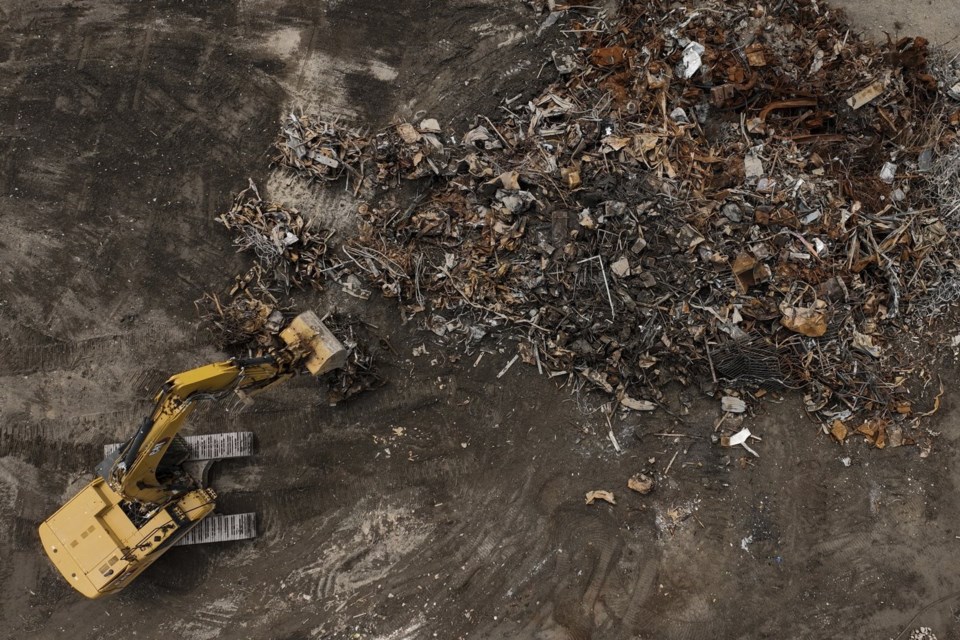ALTADENA, Calif. (AP) — Candace Frazee recently walked through the burnt remains of The Bunny Museum, searching for anything that could be salvaged before workers cleared the land.
The Eaton Fire in Southern California in January scorched more than 60,000 bunny objects and memorabilia, leaving behind mounds of ash, steel and concrete littered across the landscape. Giant bunny statues that once greeted guests were left just wiry, hollow skeletons. Her home in the back was also gone.
Yet amid the debris, there are valuable materials being redeemed: Metal, concrete and some trees are being recycled and given new life.
“It's fantastic. It's absolutely fantastic,” said Frazee of recycling the materials, who co-founded the museum with her husband. “That's the right thing to do.”
After the Palisades and Eaton fires scorched entire neighborhoods, the Army Corps of Engineers set up operations to recycle concrete and metal from mostly fire-damaged homes. Metal is compacted and concrete is crushed, then trucked to recycling facilities before re-entering the supply chain for future uses. And some trees and shrubs are processed and sold.
“A lot of this material can be reused in future construction, and that’s just good for the environment,” said Col. Sonny Avichal, an Army Corps commander for the Eaton Fire. “And so there is definitely this notion of, you know, a lot of the stuff that we’re able to recover will actually come back and help rebuild Altadena.”
The agency said these operations have sped up recovery efforts, reduced waste going to landfills and helped lower the number of trucks on the road, but they've also sparked some worries. Residents have raised concerns that the work produces or kick up particles into the air. The Army Corps maintains they're ensuring operations are safe by monitoring air quality and continually watering the sites to minimize dust.
Steel is an “infinitely recyclable” material
A large dump truck filled with wiry and garbled steel arrived at an Altadena golf course that had been partially burned. The metal pulled from fire-destroyed properties was compacted here before being trucked to a recycling facility where it can be melted, cast and resold. A steel beam can become a steel beam again, or be morphed into a car door or roof panel.
Across the globe, the steel industry represents an estimated 8% of planet-warming emissions, and just 1 to 2 % in the U.S. — the fourth largest steel producer. And according to the American Iron and Steel Institute, a trade association, recycled steel doesn't lose its quality. Annually, some 60 to 80 million tons of steel scrap are recycled into new products in North America. Every refrigerator that's recycled reduces 215 pounds of carbon dioxide emissions, according to the group's estimates.
“Steel is infinitely recyclable,” said Adina Renee Adler, executive director of the Global Steel Climate Council, an industry group working to reduce carbon emissions. “It is, in fact, the most recycled material out of everything that we have.”
Adler hopes people who lost homes to the fires will feel a glimmer of hope knowing some of those materials will be given new life. That could be for somebody else, somewhere else, or to build their own homes anew.
Recycling concrete has environmental perks
The concrete that arrived to these sites is pulverized into large concrete chunks piled 10 feet (3.05 meters) high into inch-and-a-half and 3 inch pieces before being trucked to local construction materials companies.
In its new form, concrete can be used to elevate ground in construction sites, for example, or provide a base layer before pavement is applied, or be used to create concrete again.
Making concrete is responsible for roughly 8% of global carbon dioxide emissions and 2% in the U.S., most of which come from producing and processing its predecessor, cement. That's because coal and other fossil fuels, which emit greenhouse gases when burned, are the main energy sources for making cement, and the actual chemical reaction that occurs when producing it also releases planet-warming emissions, said Ben Skinner, a manager on the cement and concrete team with RMI, a group working to accelerate the clean energy transition.
But recycling concrete doesn't substantially lower its carbon footprint, he added. It does, however, have “great environmental impacts” because it reduces the extraction of new raw materials when it's turned into aggregate — stuff like sand or gravel used to make concrete — while still producing high quality material. It also keeps waste from going to landfills.
Some trees could also be used in rebuilding
Large trees were knocked onto homes and parkways from the same powerful winds that sent fires out of control, and the infernos scorched canopies. Trees that fell into ash get sent to landfills. Others that are still standing and pose a safety risk are cut down.
Some logs are sent to local mills to be manufactured into lumber that can be used in the rebuilding process. Others are mulched to become soil amendment, the name for organic matter added to soil to improve its quality, then sold to companies and farmers, said Matthew Long, senior program manager for Environmental Chemical Corporation, the contractor running the operations.
Long has done fire recovery work for nearly a decade — including in Hawaii after the Lahaina fires and other California blazes in 2017 and 2018. “It's really rewarding work,” he said. “You’re interacting with someone who lost everything daily and helping them move to the next step of recovery.”
___
The Associated Press receives support from the Walton Family Foundation for coverage of water and environmental policy. The AP is solely responsible for all content. For all of AP’s environmental coverage, visit https://apnews.com/hub/climate-and-environment.
Dorany Pineda, The Associated Press




